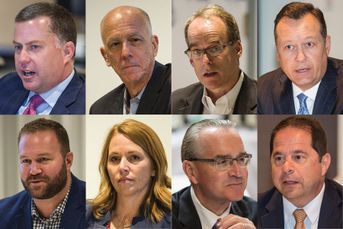Mary Jo White: 3 areas of oversight for the Treasury market
This is an edited speech given Oct. 24 by Mary Jo White, chairwoman of the Securities and Exchange…
This is an edited speech given Oct. 24 by Mary Jo White, chairwoman of the Securities and Exchange Commission, at a conference in New York on The Evolving Structure of the U.S. Treasury Market, the second annual conference on this topic.
It is a privilege to join you again this year to focus on the U.S. Treasury market, which is so vitally important for both the U.S. and the broader global economy.
Last year, I provided a high-level overview of current U.S. Treasury market regulation, stressing the need for regulators to assess the changes in the U.S. Treasury market and to consider further measures to strengthen its structure and functioning. My touchstone then was the U.S. equity markets, which bear a striking resemblance to key segments of the U.S. Treasury market.
Over the years, however, these markets have come to be regulated quite differently. And, while I cautioned against simply importing rules designed for equity markets into the U.S. Treasury market, I highlighted a number of areas where this historical divergence in regulation required revisiting in light of current market conditions.
Today, I want to speak not about the divergence in regulating two markets, but convergence — where, after considerable review, I believe our regulation of the equity markets can and should be deployed to strengthen the U.S. Treasury market. As I will outline, our focus at the SEC is on three critical areas of regulatory convergence: enhancing oversight and reporting of trading and trading platform operations; strengthening the foundational regulatory regime for these platforms and the broker-dealers that trade in the U.S. Treasury market; and working closely with Finra as it considers and reconsiders the application of its rules to the government securities markets.
My overall theme is that we should prioritize making those regulatory changes and enhancements we have now identified, based on our longstanding experience with the equity markets, that we believe will strengthen the U.S. Treasury market. I will start with regulatory oversight and reporting.
(Related read: Investors flood TIPS funds as Trump win stokes inflation concerns)
“A groundbreaking Finra rule [will] provide regulators with access to trading data for U.S. Treasury securities.”
As we do for equities, it is important that regulators have full access to comprehensive trading data about activity in U.S. Treasury securities. It is essential for understanding market dynamics and optimally exercising our oversight functions. Regular and timely access to data was essentially unavailable for the U.S. Treasury market when we met last year. But a very important and positive development occurred last week when the commission approved a groundbreaking Finra rule to provide regulators with access to trading data for U.S. Treasury securities.
In July 2016, Finra proposed the rule, which requires, beginning on July 10, 2017, its members to report transactions in U.S. Treasury securities through Finra’s TRACE system, generally by the end of the day on which they were executed. While Finra will not disseminate the trading data publicly, the data will be available for the first time to the relevant regulators to enhance our oversight of the U.S. Treasury market. All broker-dealers registered with the SEC that are Finra members will be subject to this transformative rule.
SHEDDING LIGHT ON THE MARKET
While the exact volume of U.S. Treasury securities trading to be reported by Finra members cannot be known until reporting begins, it is clear that this initiative will shed light on a significant segment of the U.S. Treasury cash market. A recent analysis by staff of the Federal Reserve Bank of New York estimated that dealer-to-customer trading accounts for more than half of all U.S. Treasury securities volume.
Both banks and Finra members transact in this portion of the market and the transparency afforded regulators by the new Finra rule will give us a more informed picture of this important segment of the market, although the full extent of dealer-to-customer trading will not be captured until banks, as well as Finra members, are required to report their transactions.
(Related read: Finra complaint: Dawn Bennett failed to testify on possible fraud linked to her clothing company)
Most commenters on Finra’s proposal supported the goal of enhancing official sector access to U.S. Treasury securities trading data. Some, however, were concerned that a trade reporting requirement that applied only to Finra members would result in a competitive disparity, given that non-Finra member firms also trade U.S. Treasury securities. For the same reason, commenters noted that an audit trail consisting only of transactions effected by Finra members would not provide regulators with a comprehensive understanding of the market without the same requirements for bank-dealers.
COMPREHENSIVE DATA
These are important issues that underscore the importance of gaining access to comprehensive trading data on the U.S. Treasury market. And I am very pleased that the Federal Reserve Board announced [Oct. 21] that it intends to collect U.S. Treasury securities transaction data from banks, with the possibility that Finra may act as agent on the board’s behalf for such collection. Extending regulatory reporting to all U.S. Treasury securities transactions would enable all regulators to optimize our oversight of the U.S. Treasury market and will yield immense benefits.
As we applaud this important development and before I move on to market intermediaries, I want to be clear that public transparency is the next critical step to consider. Public reporting obviously implicates important additional considerations about pricing and liquidity, with which most of you are well familiar. But, as I said last year, I continue to think that this is a question of “how best” to deliver public transparency, not “whether” to do so. And I am committed to working with my fellow regulators to arrive at the optimal solution.
Another area where current conditions in the U.S. Treasury market highlight a need for regulatory convergence is the foundational registration and regulation of intermediaries. The federal securities laws prescribe separate regulatory regimes for different types of market intermediaries.
Notably, there is a regime for the registration and oversight of trading platforms, exchanges and alternative trading systems (ATSs). And there is a separate regime for the registration and oversight of firms acting as brokers or dealers. These regimes have historically not reached activities in the U.S. Treasury market to the same extent as activities in the equity markets. It is time for change.
The evolution of the U.S. Treasury market over recent years has eliminated many of the rationales for the historical regulatory distinctions. And at the SEC, I have asked the staff to recommend ways of extending for the first time critical aspects of this securities regulatory framework to U.S. Treasury market intermediaries. This well-established regulatory paradigm, which has greatly benefited investors and our equity markets, should also now be applied to the evolving U.S. Treasury market.
TRADING PLATFORMS
Trading platforms provide facilities for bringing together and matching the orders of multiple buyers and sellers. In the equity markets, registered exchanges execute the majority of volume, approximately 63.8% in the second quarter of 2016, and are the primary sources of public price discovery; equity ATSs collectively account for another significant portion of U.S. equity volume, approximately 15.3% in the second quarter of 2016. Both are significantly, although differently, regulated by the SEC.
In the highly active market for on-the-run U.S. Treasury securities, non-exchange trading platforms perform the essential function of bringing buyers and sellers together for a large portion of the volume. The regulatory regime for U.S. Treasury platforms, however, is currently quite different from that applicable to the platforms that trade equities.
For example, as I flagged in my remarks last year, the important operational integrity standards of Regulation SCI — Systems, Compliance and Integrity — now apply to critical equity market infrastructures, including exchanges, significant equity ATSs, securities information processors, clearing agencies and Finra. Equity ATSs are also subject to Regulation ATS, which requires, among other things, registration as a broker-dealer and regulatory disclosures about operations, and which would be further enhanced and made public under our proposal issued late last year.
There are also other important provisions of Regulation ATS requiring efficient and fair use of primary trading venues by equity market participants, including, for example, the requirement that ATSs with significant volume provide market participants with fair access to the ATSs’ services and pool of liquidity.
These basic and critical regulatory standards do not apply to platforms that trade U.S. Treasury securities. When the SEC originally adopted the regulatory structure for equity ATSs in 1998, it decided to exclude platforms that solely trade government securities.

Although the commission acknowledged that platforms trading only government securities raise issues similar to those raised by platforms trading equity and other debt securities, platforms for government securities were excluded from Regulation ATS at that time in deference to the joint regulation schema for government securities, which the SEC shares with the Department of the Treasury and federal banking regulators.
Market conditions and the securities regulatory regime have evolved considerably since 1998. When the commission proposed rules last November to enhance the public transparency and regulatory oversight of equity ATS operations, the SEC requested comment on whether Regulation ATS, including the newly proposed rules, should be applied to platforms that trade U.S. Treasury securities. Most commenters generally supported increasing operational transparency for U.S. Treasury platforms and provided a number of helpful comments on how to apply our regulatory regime to these market participants.
In close consultation with our fellow regulators, I have reassessed the decision of nearly 20 years ago to exclude from Regulation ATS platforms that trade solely government securities. And I have recently directed the SEC staff to develop recommendations for the commission to consider applying measures that would further enhance our regulation of platforms that trade government securities.
I expect these recommendations to address whether and how to apply the various provisions of Regulation ATS and Regulation SCI to platforms that currently trade government securities. Application of Regulation ATS provisions, as recently proposed to be amended, would serve to enhance regulatory oversight of U.S. Treasury trading platforms and improve the transparency of operations and protections for investors, while promoting a fair and competitive market for trading U.S. Treasury securities. Application of Regulation SCI to these systems would also significantly strengthen U.S. Treasury market infrastructure and enhance its resilience.
DEALERS IN TREASURY SECURITIES
Another core element of the securities regulatory regime is registration and oversight of market intermediaries that act as brokers or dealers. The relevant concepts in the securities laws are straightforward: Brokers act as agent in executing the orders of customers; dealers act as principal engaged in the business of buying and selling for their own accounts. And these core concepts in the statutory definitions of a “broker” and “dealer” are the same for firms that trade government securities as they are for firms that trade other types of securities.
A firm that acts as a broker or as a dealer, or in both capacities, when trading equities or other securities is generally required to register with the SEC and subject itself to SEC oversight. It is also generally required to become a member of an exchange or Finra, and subject itself to that source of oversight as well.
(Related read: Elizabeth Warren asks Obama to replace SEC’s Mary Jo White)
A firm that acts as a government securities broker or dealer, or in both capacities, generally is required to register and subject itself to the oversight of its appropriate regulatory agency. If it is not a financial institution like a bank, a government securities broker or dealer must also become a member of an exchange, or Finra, which is the only self-regulatory organization for off-exchange securities activity. The operation of active principal trading firms — whether in the equities or U.S. Treasury markets — gives rise to the question of whether those firms are acting as dealers and registered as such under the federal securities laws.
As reported in the Joint Staff Report on the U.S. Treasury market volatility of Oct. 15, 2014, bank dealers represented 30%-40% of volume on the interdealer trading platforms for cash U.S. Treasury securities. These firms are bank-owned and SEC-registered broker-dealers subject to our comprehensive regulatory regime, and typically engage in, among other things, client trading. This does not appear currently to be the case for other major participants in the U.S. Treasury market identified in the Joint Staff Report — active principal trading firms.
The Joint Staff Report made important observations concerning the nature and characteristics of the trading activity of the 10 most active principal trading firms. These observations suggest a course of conduct that has the hallmarks of traditional dealing activity — being engaged in the business of buying and selling securities for its own account.
Specifically, the report noted that these firms represent more than 50% of volume on the so-called “interdealer” trading platforms for cash U.S. Treasury securities and that they trade more frequently and, on average, in smaller size per trade than bank dealers. The report also observed that their median end-of-day positions are much smaller than that of the median bank dealer, both in absolute terms and especially relative to trading volume.
For example, the median end-of-day position for these principal trading firms was only 4.4% of their total buying and selling for the day, demonstrating a significant intraday position turnover. In contrast, bank-dealer median end-of-day positions were 19% of their total volume, indicating that registered bank-dealers actually turn over inventory at a much lower rate than principal trading firms.
As you would expect, there is a significant concern that this activity indicates that certain principal trading firms are acting as dealers, but without the appropriate registration and regulation that is designed to protect investors and the markets.
The regulatory regime for dealers includes, for example, net capital requirements that promote market stability by requiring a firm to maintain sufficient liquid assets to wind down in an orderly fashion with minimal impact on counterparties and markets.
Dealers are also subject to examination of their books and records, as well as specific anti-manipulation and anti-fraud provisions that extend beyond the general restrictions applicable to all market participants. And dealers that are Finra members must comply with a suite of important market conduct and other Finra rules.
(Related read: SEC uses F-Squared saga to drive home due diligence message)
For SEC-registered brokers and dealers, this regulatory regime also includes the SEC’s important market access rule, a critical safeguard for our modern electronic markets against the harmful instability that can be caused by the operational mistakes at a single firm.
It requires dealers that have direct market access — or that provide such access to others — to implement robust controls to manage the financial, regulatory, operational and other risks of such access. These controls must address, for example, the risk of high-speed algorithms malfunctioning and disrupting the market. The trading activity of nondealers, by contrast, is covered by this rule if they obtain their market access either through a dealer or ATS that is itself obliged to comply.
As I recently announced, the staff is now assembling their work on disruptive trading practices in the equities markets and will soon publish it for full consideration by all market participants and the public generally. The goal is to engage a thorough and data-driven public dialogue about the optimal regulatory response to potentially disruptive trading strategies, including the adoption of an anti-disruptive trading rule.
BROKER-DEALER CONDUCT
My final observations today will touch on another important area of regulatory convergence — the standards that govern broker-dealer conduct. We must review such standards, and all aspects of market structure, on a continuing basis to ensure that the standards remain robust as market practices evolve in response to the forces of technology, competition and regulation.
In August, Steve Luparello, our great director of the Division of Trading and Markets, sent a letter to Finra about its oversight of member activities in the U.S. Treasury market.
50%Portion of volume on interdealer trading platformsfor cash U.S. Treasuries attributed to just 10 firms
The letter, which is available on the SEC’s website, commended Finra for its recent steps contributing to the broader effort of promoting integrity in the U.S. Treasury market. These include the regulatory trade reporting proposal just approved, as well as Finra’s new rule applying certain of its rules governing markups and commissions to transactions in exempted securities that are government securities.
That letter also asked Finra to expand on these efforts by undertaking a comprehensive review of its rule book as it relates to U.S Treasury securities to identify Finra rules that exclude or may otherwise not apply to U.S. Treasury securities (or government securities more generally) or for which the applicability of the rule to U.S. Treasury securities requires clarification. The letter also requested a preliminary schedule for how and when Finra will address any identified gaps.
Finra has already responded to this request, and I commend Finra and its new president and chief executive officer, Robert Cook, for providing an extremely useful overview of the relevant Finra rules and their application to the U.S. Treasury market.
CURRENT RULES
Finra’s letter, which is available on Finra’s and the SEC’s websites, details its various rules currently applicable to government securities; rules that are not currently applicable but that Finra staff believes may be appropriate for government securities; and rules that are not applicable because they were specifically adopted to address other types of securities or activities.
Finra staff expects to present a proposal on a range of these issues to its board of governors in the first quarter of 2017. The proposal may include the application of important conduct rules to government securities, including U.S. Treasury securities. Finra staff noted, for example, that it may be appropriate and suitable to apply rules addressing front-running of block transactions, prohibitions against trading ahead of customer orders, trading ahead of research reports and certain conflicts of interest provisions to the government securities market.
Learn more about reprints and licensing for this article.








